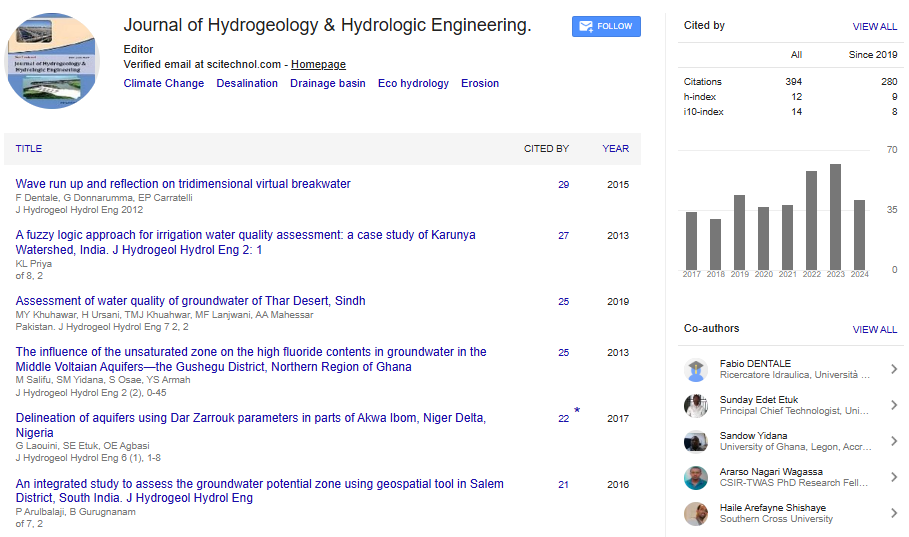Perspective, J Hydrogeol Hydrol Eng Vol: 13 Issue: 2
Worldwide Factors Affecting Upcoming River Flooded Hazard: Comprehending the Intricate Dynamics
William Hunt*
Department of Agriculture and Environment, The University of Western Australia, Crawley, Australia
*Corresponding Author: William Hunt,
Department of Agriculture and
Environment, The University of Western Australia, Crawley, Australia;
E-mail: huntwilliam@gmail.com
Received date: 27 March, 2024, Manuscript No. JHHE-24-138800;
Editor assigned date: 29 March, 2024, PreQC No. JHHE-24-138800 (PQ);
Reviewed date: 12 April, 2024, QC No. JHHE-24-138800;
Revised date: 19 April, 2024, Manuscript No. JHHE-24-138800 (R);
Published date: 26 April, 2024, DOI: 10.4172/2325-9647.1000316
Citation: Hunt W (2024) Worldwide Factors Affecting Upcoming River Flooded Hazard: Comprehending the Intricate Dynamics. J Hydrogeol Hydrol Eng 13:2.
Description
River flooding poses a significant risk to communities worldwide, with the potential for devastating impacts on human lives, infrastructure, and ecosystems. Understanding the global drivers of future river flood risk is essential for developing effective modification and adaptation strategies. These drivers are multifaceted, encompassing climatic, hydrological, socio-economic, and environmental factors that relationship in complex ways. This article explores the key global drivers shaping future river flood risks and the implications for policy and management.
Climate change is a primary driver of future river flood risk. Rising global temperatures are expected to intensify the hydrological cycle, leading to more extreme weather events. Increased precipitation, particularly intense and prolonged rainfall, can overwhelm river systems, causing them to overflow. Additionally, the melting of glaciers and snowpack, driven by higher temperatures, contributes to higher river volumes, especially in regions reliant on meltwater for their river systems. This phenomenon is particularly pronounced in mountainous regions and polar areas, where significant glacial melt is occurring.
Rapid urbanization and changes in land use significantly impact river flood risks. The conversion of natural landscapes into urban areas typically involves the replacement of permeable surfaces with impermeable ones, such as concrete and asphalt. This change reduces the land’s natural ability to absorb rainfall, leading to increased surface runoff that can quickly swell rivers and cause flooding. Additionally, the expansion of cities into floodplains exacerbates the risk, as more people and assets are located in high-risk areas. Deforestation for agriculture or urban development also plays a role, as the loss of trees reduces the interception and absorption of rainwater.
Socio-economic factors, including population growth, economic development, and governance, are precarious drivers of future river flood risk. Population growth, particularly in developing countries, often leads to the expansion of settlements into vulnerable flood-prone areas. Economic development can increase flood risk through infrastructure development that disregards floodplain management practices. On the other hand, inadequate governance and lack of enforcement of land-use regulations can exacerbate the situation, leading to poorly planned urban expansion and insufficient flood protection measures.
Human interventions in river systems, such as dam construction, water diversion, and drainage modifications, can significantly alter hydrological regimes and influence flood risk. Dams, while often built for flood control, irrigation, and hydroelectric power, can disrupt natural water flow and sediment transport, potentially increasing flood risk downstream if not managed properly. Similarly, water diversions for agriculture or urban use can lower river flows during dry periods but may lead to increased flood risk if excess water is suddenly released during periods of heavy rainfall.
Environmental degradation, including the destruction of wetlands and riparian zones, reduces the natural capacity of ecosystems to mitigate flooding. Wetlands act as natural sponges, absorbing excess water and releasing it slowly, thereby reducing flood peaks. The destruction of these areas for agricultural or urban development diminishes this natural flood control mechanism, leading to higher flood risks. Additionally, soil degradation through practices such as overgrazing and poor agricultural techniques reduces soil permeability, increasing surface runoff during heavy rainfall.
Climate variability and the increasing frequency and intensity of extreme weather events, such as hurricanes, typhoons, and monsoon rains, pose significant risks for river flooding. These events can cause sudden and extreme increases in river water levels, overwhelming flood defenses and causing widespread damage. The unpredictability of such events makes it challenging to prepare and adapt, necessitating robust and flexible flood risk management strategies.
Conclusion
The global drivers of future river flood risk are diverse and interconnected, requiring a comprehensive approach to manage and mitigate their impacts. Addressing these drivers involves a combination of improved climate modeling, sustainable land use planning, enhanced floodplain management, and investment in resilient infrastructure. International cooperation and strong governance are essential to implementing effective flood risk reduction strategies. By understanding and addressing these drivers, we can better prepare for and mitigate the impacts of future river flooding, protecting communities and ecosystems worldwide.
 Spanish
Spanish  Chinese
Chinese  Russian
Russian  German
German  French
French  Japanese
Japanese  Portuguese
Portuguese  Hindi
Hindi 
